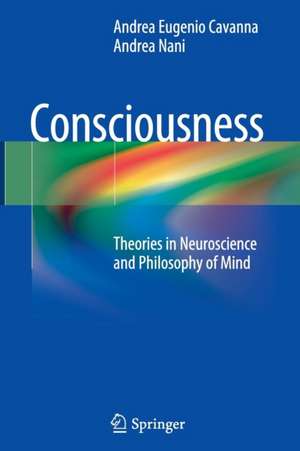Consciousness: Theories in Neuroscience and Philosophy of Mind
Autor Andrea Eugenio Cavanna, Andrea Nanien Limba Engleză Paperback – 23 aug 2016
| Toate formatele și edițiile | Preț | Express |
|---|---|---|
| Paperback (1) | 580.17 lei 6-8 săpt. | |
| Springer Berlin, Heidelberg – 23 aug 2016 | 580.17 lei 6-8 săpt. | |
| Hardback (1) | 783.50 lei 6-8 săpt. | |
| Springer Berlin, Heidelberg – 10 oct 2014 | 783.50 lei 6-8 săpt. |
Preț: 580.17 lei
Preț vechi: 682.55 lei
-15% Nou
Puncte Express: 870
Preț estimativ în valută:
111.02€ • 116.20$ • 92.40£
111.02€ • 116.20$ • 92.40£
Carte tipărită la comandă
Livrare economică 31 martie-14 aprilie
Preluare comenzi: 021 569.72.76
Specificații
ISBN-13: 9783662510124
ISBN-10: 366251012X
Pagini: 220
Ilustrații: XVI, 203 p. 41 illus., 34 illus. in color.
Dimensiuni: 155 x 235 x 12 mm
Greutate: 0.31 kg
Ediția:Softcover reprint of the original 1st ed. 2014
Editura: Springer Berlin, Heidelberg
Colecția Springer
Locul publicării:Berlin, Heidelberg, Germany
ISBN-10: 366251012X
Pagini: 220
Ilustrații: XVI, 203 p. 41 illus., 34 illus. in color.
Dimensiuni: 155 x 235 x 12 mm
Greutate: 0.31 kg
Ediția:Softcover reprint of the original 1st ed. 2014
Editura: Springer Berlin, Heidelberg
Colecția Springer
Locul publicării:Berlin, Heidelberg, Germany
Cuprins
Part 1. Philosophical Theories of Consciousness: David Chalmers.- Paul and Patricia Churchland.- Tim Crane.- Donald Davidson.- Daniel Dennett.- René Descartes.- Jerry Fodor.- Jaegwon Kim.- William Lycan.- Collin McGinn.- Thomas Nagel.- Alva Noë.- Hilary Putnam.- David Rosenthal.- John Searle.- Part 2. Scientific Theories of Consciousness: Bernard Baars.- Francis Crick and Christof Koch.- Antonio Damasio.- Stanislas Dehaene.- Merlin Donald.- John Eccles and Karl Popper.- Gerald Edelman.- Nicholas Humphrey.- Julian Jaynes.- Benjamin Libet.- John Kevin O'Regan.- Roger Penrose and Stuart Hameroff.- Giulio Tononi.- Max Velmans.- Semir Zeki.
Recenzii
“For any reader wanting to find out how thephilosophical debates between dualistic and identity theories and a variety ofintermediate positions have unfolded over the last decades … this book is aperfect starting point. … This book makes clear that there is a great deal ofopportunity for philosophers, neuroscientists and clinicians to learn from eachother when discussing disorders of consciousness, dissociative states or the alterationsof qualia … associated with synaesthesia or hallucinatory experiences.” (DavidE. J. Linden, Cognitive Neuropsychiatry, Vol. 20 (5), 2015)
Textul de pe ultima copertă
This book aims to depict a wide landscape by reviewing some of the most important scientific and philosophical theories concerning the nature of mind and consciousness. Current theories on the mind-body problem and the neural correlates of consciousness are presented through a series of biographical sketches of the most influential thinkers across the fields of philosophy of mind, psychology, and neuroscience.
The book is divided into two parts: Part 1 is dedicated to philosophers of mind, whereas Part 2 encompasses neuroscientists and experimental psychologists. Each part comprises fifteen short chapters, with each chapter being dedicated to one author. A brief introduction is given on his or her life and most important works, with explanation of influences and of the impact that the ideas contained in these works had on the communities of psychologists, neuroscientists, and philosophers of the time. The most influential theory/ies developed by each author are then explainedand examined, with the aim of analyzing the strengths and weaknesses of the different approaches to the nature of consciousness. An annotated list of essential references concludes each chapter.
The book is divided into two parts: Part 1 is dedicated to philosophers of mind, whereas Part 2 encompasses neuroscientists and experimental psychologists. Each part comprises fifteen short chapters, with each chapter being dedicated to one author. A brief introduction is given on his or her life and most important works, with explanation of influences and of the impact that the ideas contained in these works had on the communities of psychologists, neuroscientists, and philosophers of the time. The most influential theory/ies developed by each author are then explainedand examined, with the aim of analyzing the strengths and weaknesses of the different approaches to the nature of consciousness. An annotated list of essential references concludes each chapter.
Caracteristici
An agile introduction to the most influential thinkers in the field of consciousness studies from the philosophical and neuroscientific perspectives Encompasses theoretical and empirical approaches in an accessible and entertaining style Ideal textbook for both neuroscience and philosophy of mind courses Relevant for clinicians, researchers and scholars across different specialties











